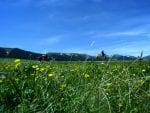Last Updated on 7 December 2023 by Cycloscope
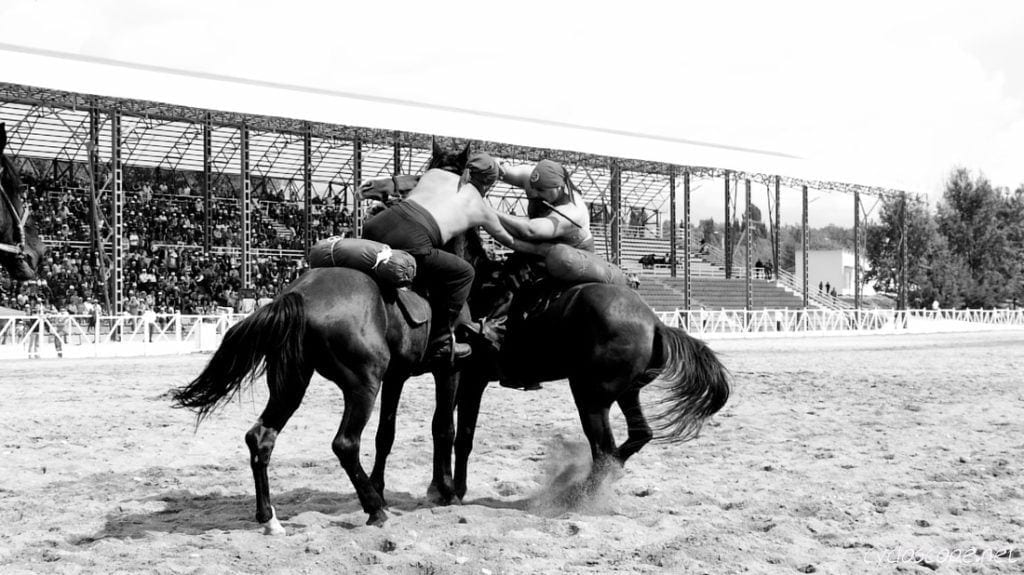
Kyrgyzstan, Issyk Kul lake, Cholpon Ata town, First World Nomad Games. Play polo with a dead goat (Kok Boru or Buzkashi), throw your opponent from his horse in a tense Enish fight, or grab your bride (or slap your groom) in a Kyz Kuu race!
So here we are, Kyrgyzstan, Issyk Kul Lake, Cholpon Ata town, First World Nomad Games, the history takes place before our eyes! But wait a moment, what’s this Nomad Games thing?
The historical and political background (in pills)
Let’s start from the beginning: Central Asia nations have a common history that goes far back to the Soviet times. Nomad tribes wandered this wide and tough lands for centuries, unified under the Gengis Khan empire and then again by Tamerlan in the XIV century.
The troops of both conquerors mostly spoke Turkic Languages, which were spread all over Asia to the edges of Europe. Kyrgyz, Kazakh, Azeri, and Uzbek are all part of the Turkic language family and are almost intelligible to each other. Along with the language comes the culture and the games that are part of it.
Then Soviet times came and so did the Russification. But, with the fall of the Union, the Turkic identity came out again. And in modern geopolitics, this could play an important role.
The idea of the Games first appeared during the 2011 visit of Turkish Prime Minister Recep Tayyip Erdoğan to Kyrgyzstan (cit), as a way to improve the relationship between the Turkic-speaking countries and extend the Turkish political influence in countries that are still strongly influenced by Russia.
A messy start
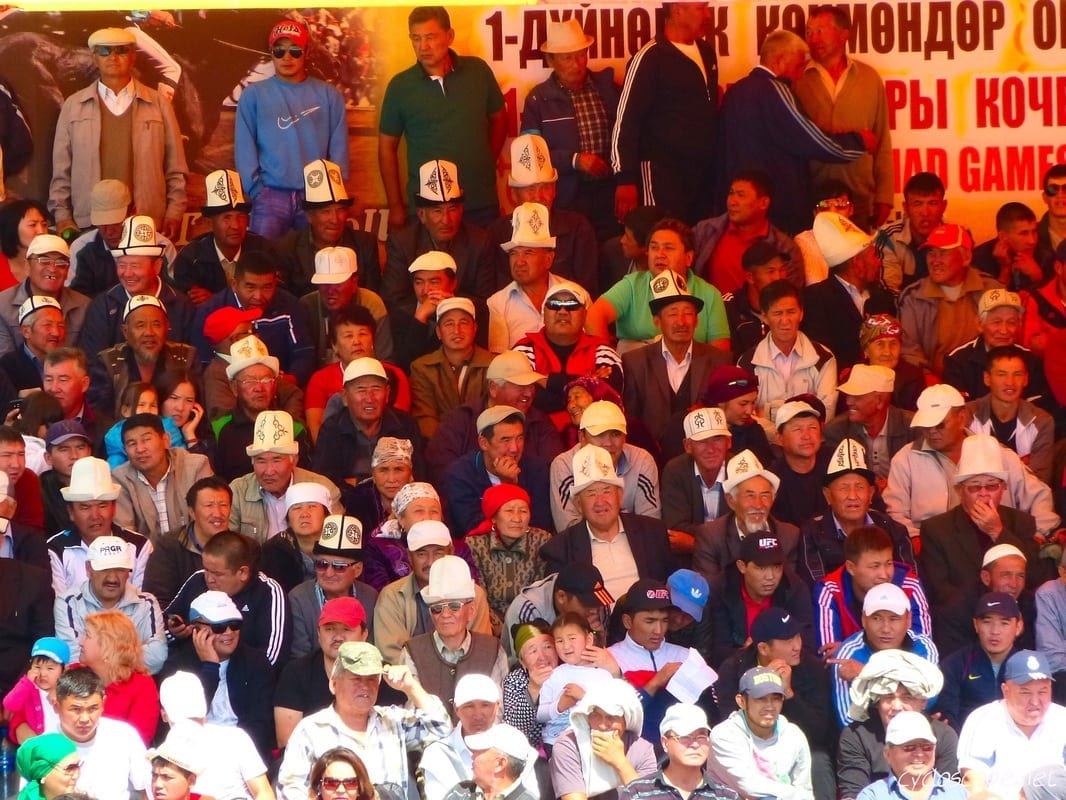
Yesterday, the press office of the racecourse told us to show up this morning at 8 am to have our accreditation. We wake up at dawn and go, but we are faced with an array of soldiers that prevent the passage. We try to explain that we have an appointment but no way.
Besides, we were told this morning there will be the opening ceremony of the games. At the end, one of the soldiers tells us that it will open at 9 am, and after a little while, he comes back and tells us it will open at 10. Not a bad beginning. Let’s go have breakfast at the cafe across the street. When we get back, we are told everything will begin at 7 pm tonight!
Nobody knows anything about the program, so we go for a walk around the town and visit all of the guesthouses looking for a cheaper place and we find it right next to yesterday’s one, half the price, has a beautiful garden, kitchen, and the wi-fi works.
The opening ceremony

We go to the beach, very crowded and full of tourists, as opposed to all the other places seen until now around Issyk Kul. Daniele also manages to take a bath. Back from the beach, we meet a journalist, he tells us that the games had already begun somewhere in town, and he saw some “wrestling” matches.
But how is it possible that they began and no one knew it in the press office? And then, shall not the games begin after the inauguration ceremony? Here seems like they wake up in the morning and decide what to do. Kafka again.
We go back to the Hippodrome to attend the ceremony, it looks like trying to get to a Madonna concert, except that here it’s free. I argue with everybody because they keep on pushing from all sides, which doesn’t make sense given that the “gate” (consisting of soldiers trying to take the crowd away) is closed.
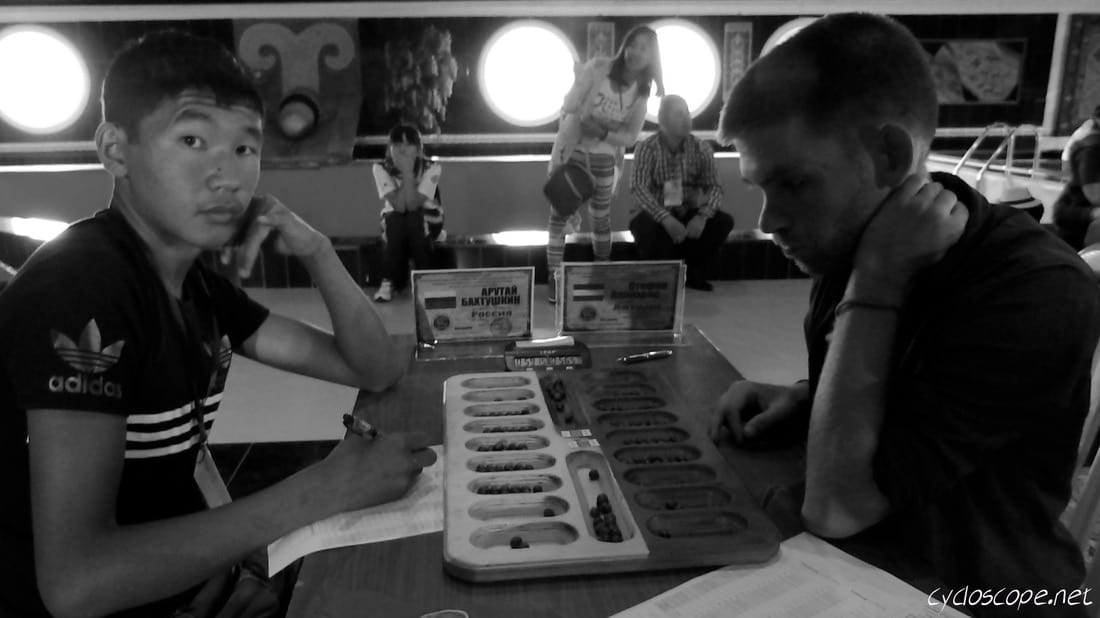
The ceremony is nothing special. But one thing strikes us at once, there are some pyramid structures with projections on them and a play of light, how could the press office think the ceremony could be held at 10 am? Mystery…
There is some group choreography, playback singing, and horses in flames with guys on their backs, also in flames. The procedure takes about an hour and a half plus another hour and a half of waiting.
Of course, there was also the usual teams’ parade, with flags and everything, but completely out of sync. As the announcer called Azerbaijan (the first country in alphabetical order), the Kazakhstan team was already parading.
There are also countries that we would never have expected such as France, Germany, Sweden, USA, and Austria, whose delegation is composed of only one member. Probably they will participate in the tournament of Toguz Korgool (a board game of the Mancala family).
The Turkish team is indeed the biggest after Kyrgyzstan, everybody in the audience has a small Turkish flag, got for free at the entrance, another smart political move.
After all the 19 flags and 400 athletes (source CNN) had done their parade, we went back ruefully to the village, hoping to see something tomorrow. We had a beer with Misha and Julius (the German giants we met months ago on the ferry to Georgia, they are here too, small world) that reached us here before going to Karakol.
Kok Boru – polo with a dead goat
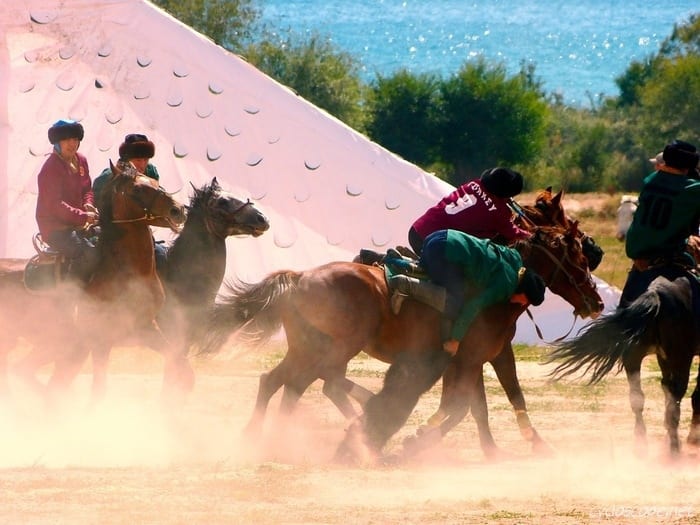
We get to the hippodrome around 10 in the morning. From some unconfirmed sources, we understood that the Kok Boru tournament should begin. Kok Boru is the Kyrgyz version of Afghan Buzkashi. Two teams of 4 horses and 4 horsemen get into a struggle trying to conquer a dead goat (the ball) to throw it in a big concrete basket and score a point.
The team is composed of a total of 10 players who can take over at any time during the match. Each player carries a whip, that is used to flog his horse, an opponent’s one, a fellow rider, or even himself. The goat is headless, with the paws cut short, it is disemboweled and filled with sand to make it the regular weight. Easy isn’t it?
The game starts of course at one o’clock, with us there are Misha and Julius, with freshly arrived girlfriends from Germany, and even Claudia and Bettina (the cycling couple we met in Bishkek). Today, contending the goat and the glory, are Uzbeks and Turks, a rip-roaring victory for Turkey.
From the gallery we can’t see much, because the field is sandy and the horses raise a lot of it, enveloping the contenders in an impenetrable cloud.
Up to the jailoo – the Nomad Games’ yurt camp
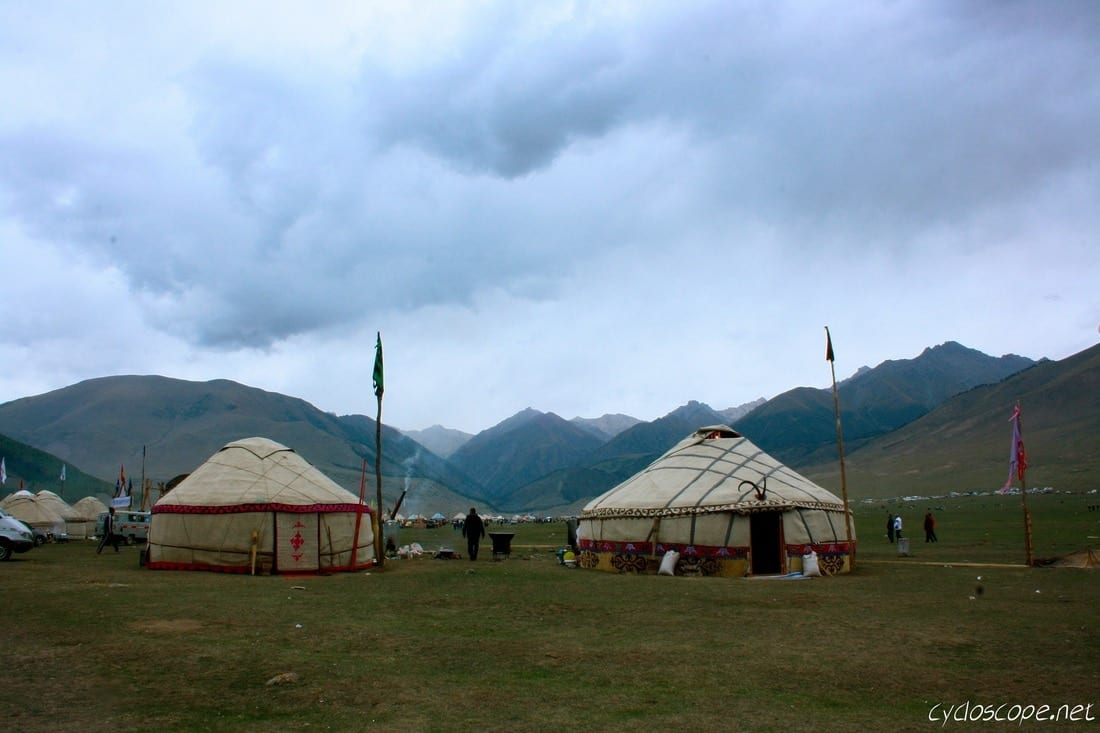
We go to Kyrchyn Jailoo, a nice place in the mountains where the cultural part of the festival is going to be held. A Jailoo is indeed a summer yurt camp usually placed high in the mountains. Today there should be an eagle hunting show and even a concert.
We go with Emile, Claudia, and Bettina after a long negotiation with taxi drivers. In theory, there must have been shuttles but in practice, there are not. In the cab: a fashion designer from Narin, another guy who seems to be his boyfriend, an unidentified lady, and us. The driver ends up with 4 gay persons in the car and appears, so to speak, in subjection. He does not say a word the whole trip.
In Kyrchyn there are a hundred yurts, divided into sectors to represent the different regions, the Jal-Alabad ones, the ones from Osh and Bishkek, etc. All of them are beautiful and decorated “to the nines” with colorful shirdak felts. Our fellow couple from Narin invited us for tea in a friend’s Yurt and we went, here was chilly. In addition to tea, we get cakes, bread, and jams. There are some singing ladies, playing a komuz, the traditional string instrument of Kyrgyzstan.
Then came another elderly lady with traditional clothes, and she even sang and recited some sort of blessing for us. Another one shows us a wolf skin, with fur and head and everything. Mostly women here in the yurt, a women’s world.
The lady who was with us in the taxi says, loudly and in English, that “those two girls” (Claudia and Bettina) look like men. Delicate and classy…
Here is our photo gallery from Kyrchyn Jailoo
Kyrgyz performing arts
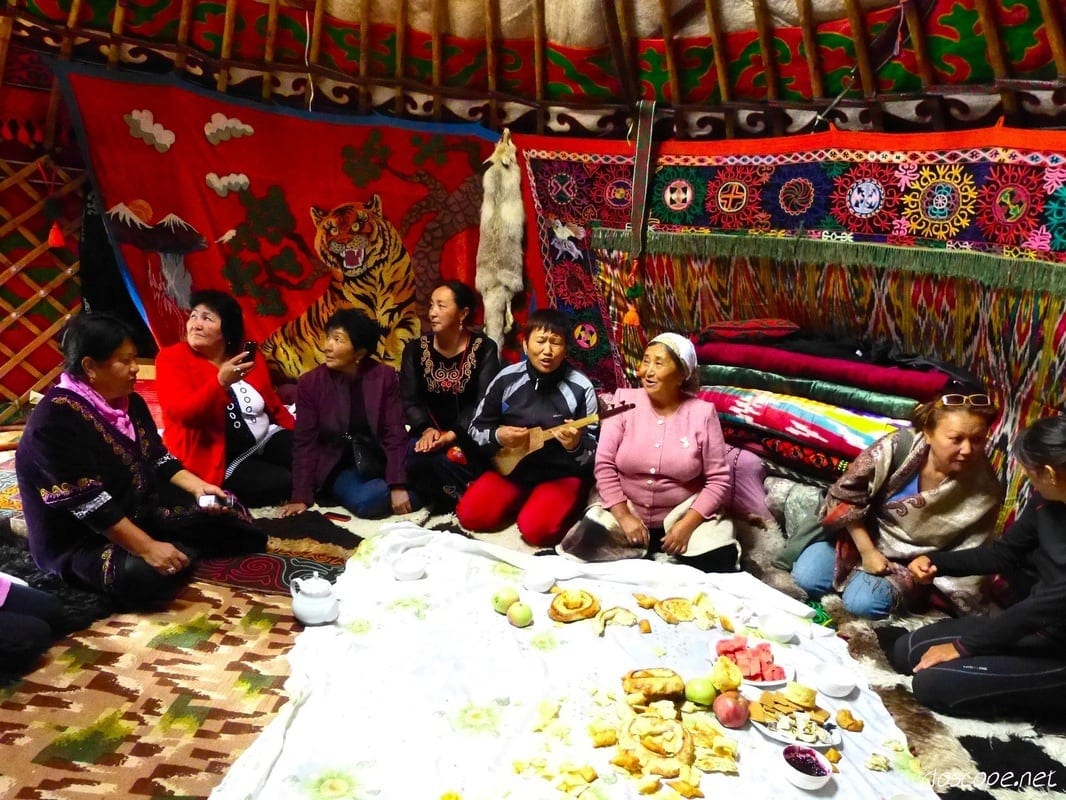
When we finally get out of the yurt the eagle hunting is over, we saw nothing but we had a pretty good time in the yurt.
We bump instead into a child who is reciting the Manas, a Kyrgyz epic poem that has been passed down orally. The Manas is an important national treasure in Kyrgyzstan, twenty times longer than the Odyssey and Iliad together. The recitation is intense and quite hypnotic, even if we of course don’t understand a word.
Then begins a concert bad enough, where everyone plays with a backing track. There comes a multi-instrumentalist who can’t play any instrument, and then another band is kicked out from the stage in the middle of the song by the announcer, we don’t understand why. He could at least let them finish the song, they were neither worse nor better than the others…
Finally, there comes a guy who plays the komuz and he’s really good!
Indeed the audience asks for an encore (we too). The announcer doesn’t approve, he is a bit of a weird guy. In the end, there’s a riot in the audience and we win. But then comes a sand storm and it all ends, so we go look for a bus to Cholpon Ata, we’re going to see the wrestling.
Central Asia wrestling
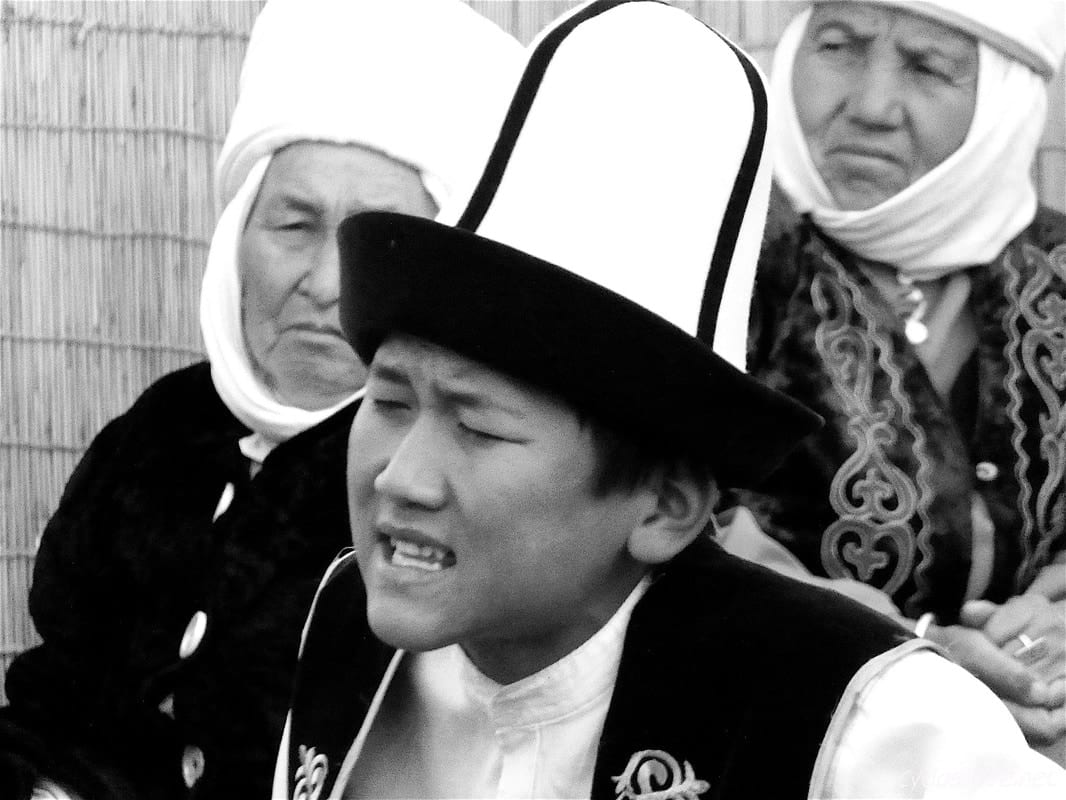
The fighting sports (the one without horses) are held at Ruk Hordo, an open-air cultural center on the west side of Cholpon Ata. First, we see some matches of Alysh, a Central Asia belt wrestling style. The athletes can’t take their hands away from the belt of the opponent and must try to have him pinned to the ground.
Then comes the Kuros (or Kurash or Kurosh or many other names) more similar to Judo. There’s a gigantic Mongolian guy that nobody can beat. Basically, for five or six fights in a row, he remains stuck in the same location and no one can move him, apparently out of an episode of Hokuto no Ken (Fudou of Mountains, for those who remember him).
Here our photo gallery of Central Asia wrestling (Alysh, Kuros)
Rux Hordo Cultural Day
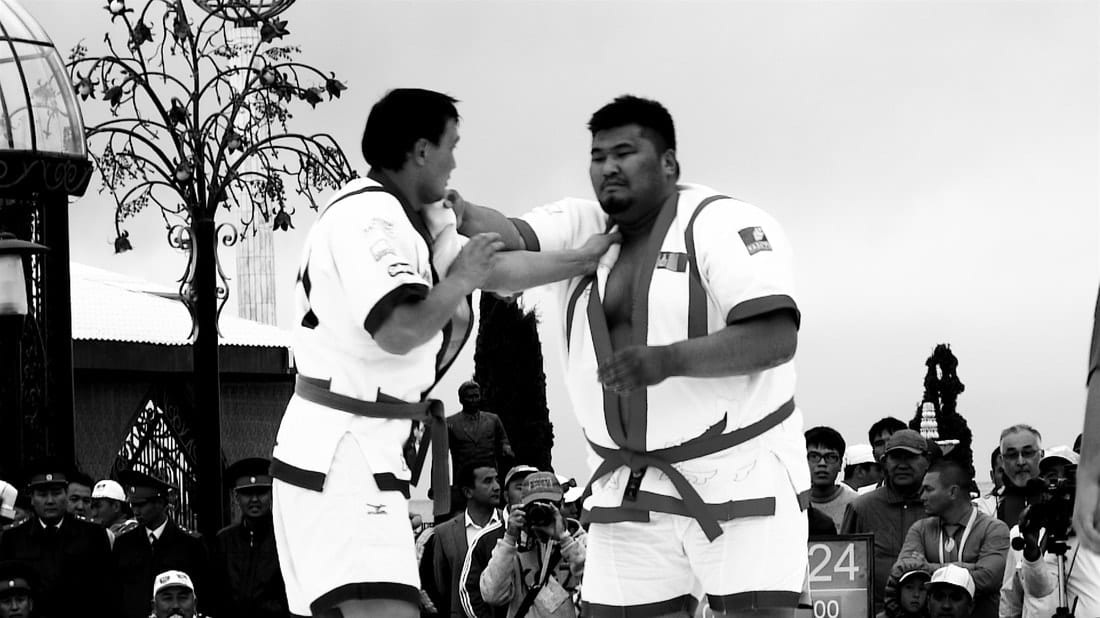
Again Rux Ordo today, for our joy it’s just in front of our guest-house. The program of the day should be demonstrations of crafts and traditional games from other countries, not better defined. There are a lot of stands with crafts from several countries, Uighur musical instruments, Ukrainian wood carving, some beautiful Tuvan jews harps, and a lutist making stunning carved Komuz.
Everything begins with everybody on the stage singing some nationalistic song, then the Azeri go on stage dressed in strange styles, with some sort of colorful pajama pants and some large heavy wooden clubs. They begin a dreadful dance, for most of the time-hopping, sometimes they say “Ale Ale” and also “Allah, Allah”. Behind those troglodyte dancers there is an equally primitive drummer with a bronze instrument, he also sings, quite out of tune.
Kyrgyz’s audience is horrified. But the Azerbaijani traditional displays are not finished yet. After the dance, begins the demonstration of a game that takes place this way: two men are sitting on the floor, facing each other. Both are holding the same wooden stick, and they must keep their feet stuck on a plank of wood.
The purpose of the game is to pull the stick from the opponent’s hands. Exciting. Given that there isn’t a league of this game, Azeris defy anyone who wants to try their hand. We are tempted…The funny thing is that the Kyrgyz challengers from the audience win all the matches!

Finally, the Azerbaijan show is over. On stage arrive some Koreans, showing up some cool Tae Kwon Do moves, and then comes a little old man who dances the Kyrgyz Kara Jorgo, a typical dance. He knows how to dance. With him, there is what seems to be his niece, a girl of about 7. At some point, the people in the audience began to approach and put money into the old man’s hat. Funny.
There is also a Ukrainian folk group of musicians/dancers with an old female singer who we loved, too bad we did not understand a word of what they said, people laughed a lot. We go home and come back after dinner, to see the fashion show during which (or before or after) there should be a concert. It’s a display of traditional clothes revised in a modern style, but the show is pretty boring to us (not much into the fashion thing), it’s cold and after an hour we go back home. There is no concert.
Here is our photo gallery of the other World Nomad Games cultural events
Inside the Hippodrome – Kok Boru, Er-Enish and Kyz Kuu
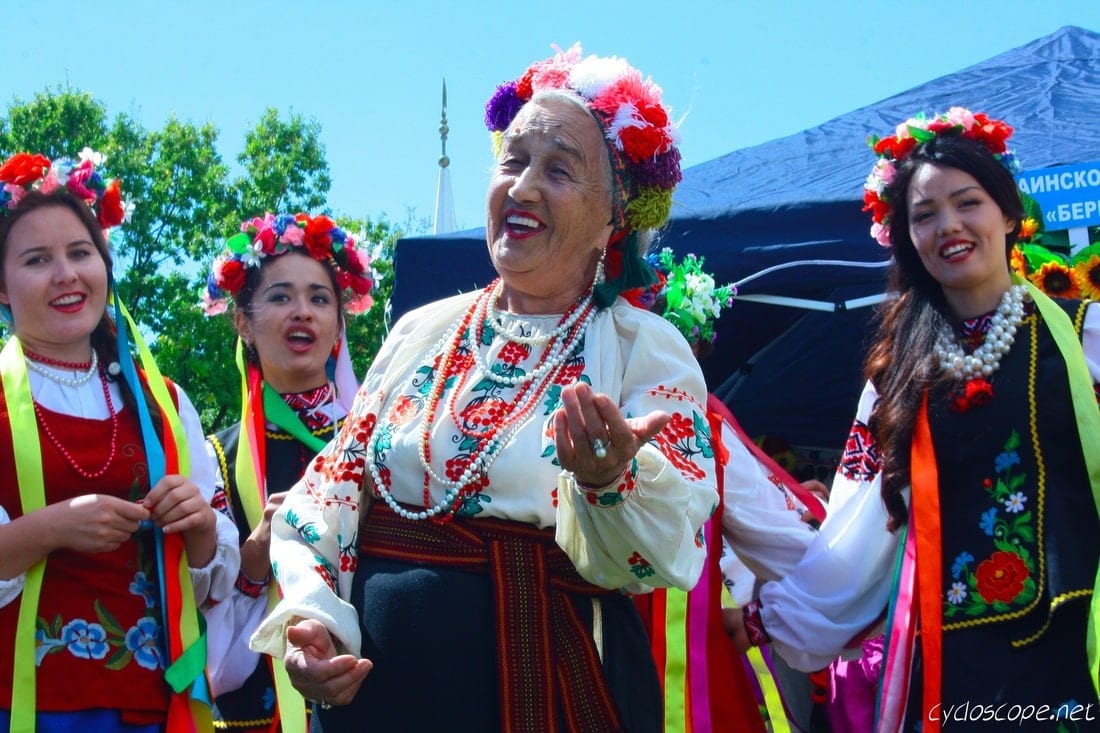
We finally got our Press Pass, and now we can wander with a more professional look between horses and wrestlers. We go immediately to the hippodrome where we can finally enter the field. Indeed, we are really inside the playground a few meters from the horses.
Er-Enish: wrestling on horses
We are quite excited to see the Er-Enish, a sort of wrestling on horseback. It works like this: inside a circle drawn in the sand, there are two horses and two riders, the aim is to beat each other and try to knock your opponent off his horse. The Afghan team consists of dudes with rude and tough faces, probably Pashtun, one gets very upset and says, “I won’t play anymore.” Of course, we do not know why.
They go to talk to the referee, and then the Afghan beats the opposing player with the flagstick of his Afghanistan flag. And then the whole team leaves. So Kazakhstan, which was the opposing team won the subsequent matches without playing. The sport is anyway quite exciting, especially from so close. But the horses do not look like having fun, sometimes they bite each other and bleed a lot.
Here our photo gallery of the Er-Enish (or Oodarish)
Turkish nomad games
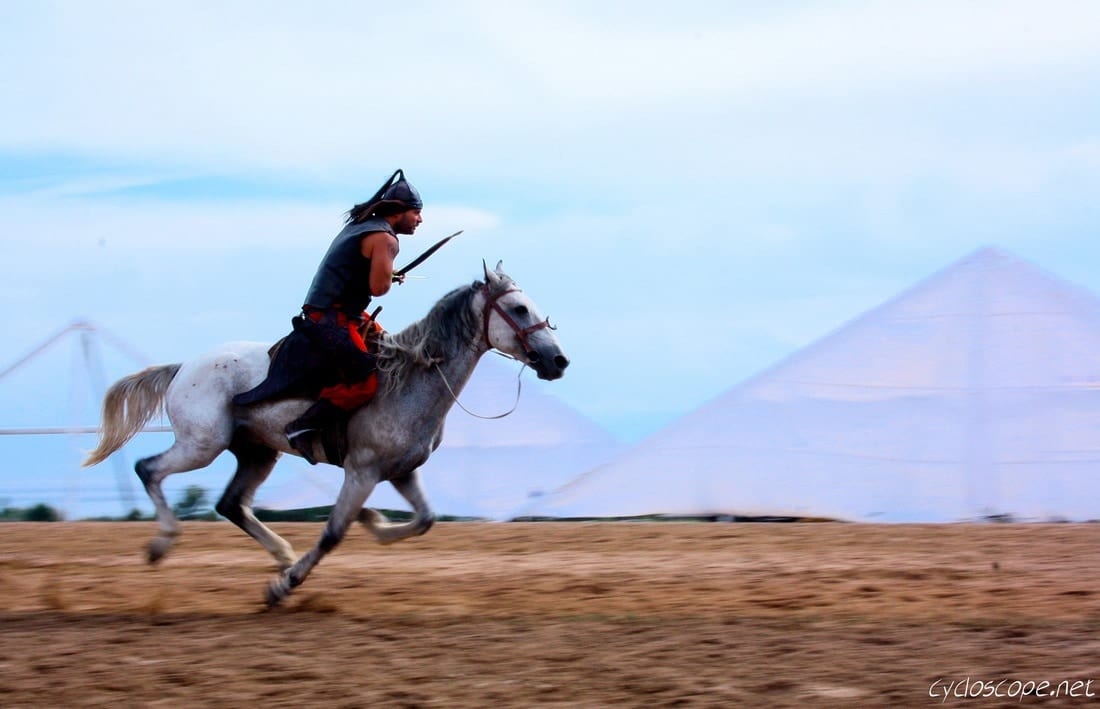
In the afternoon there is a demonstration of some Turkish games. The first is a kind of horseback archery you have to shoot arrows at a target while the horse is galloping as fast as it can. There is a Turkish guy dressed as a gladiator (or so it seems to us) who’s very good.
Then there is another team game, the Jereed, of which we have no clear understanding of the rules. To play you need guys, horses, and broomsticks. These are rolled at the opponents if they hit one point, the opponents score if they grab it on the fly. However, for those who always wanted to try, here are the rules.
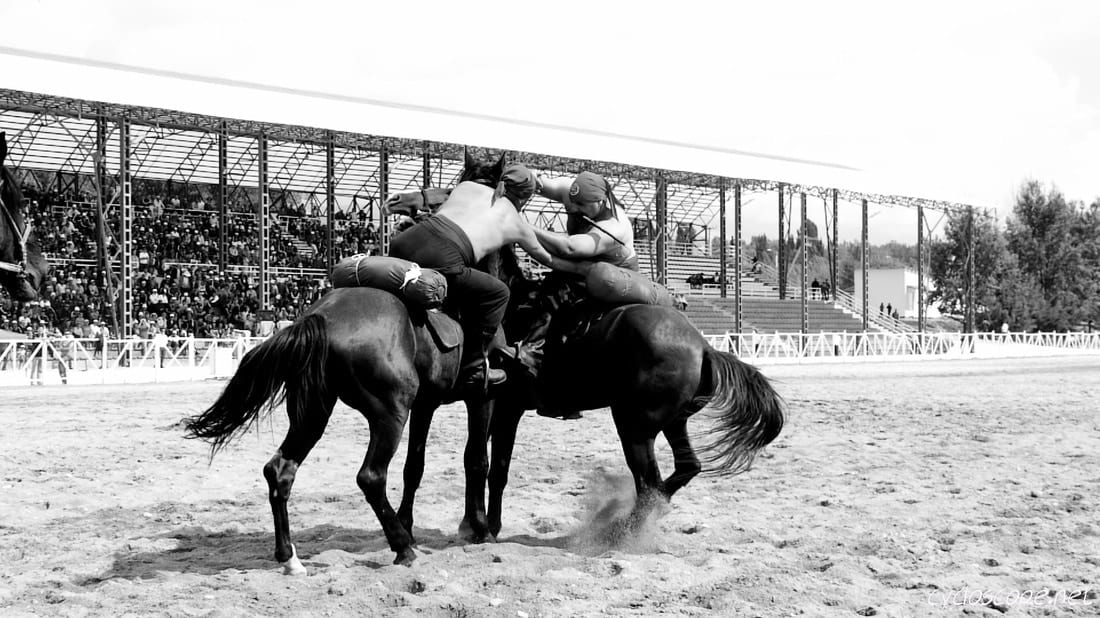
Last day of the games. At 10 o’clock we are at our beloved hippodrome, to witness the Kok Boru final, this time directly inside the playground. The teams vying for title and dinghy (money in Russian) are, guess who: Kyrgyzstan vs Kyrgyzstan! Who knows who will be the winner!
Seeing this game from inside the field, makes it appear to us, let’s say, from another perspective. And this perspective, at times, is a bit dangerous. The horses run fast and many times we have to run away so as not to be trampled. A journalist, intent on looking into his camera, was not aware of the actual proximity of the horses and was brought down.
We thought he was going to die, but he got lucky, or more precisely the horses were smart enough not to step on him. The match’s tense and quite exciting, it gets to overtime, and after a long struggle, Kyrgystan wins!
Kyz kuu: a flirt horse race
After the game, some youths are dancing out of their favorite dance, the Kara Jorgo. And then another demonstration of another game of the Kyrgyz tradition, in which a man and a woman race (on horseback, what else?). If the man wins, he can kiss the woman, but if the woman makes him bite the sand, then she can whip the man. The name of this game is Kyz Kuu.
Leaving Cholpon Ata
So it’s over, at least for us, we would not attend the closing ceremony. Back to the Guest House, we take our bikes and hit the road again. The road after Cholpon Ata fortunately is paved in a much more decent way.
We did not get far, we left at 4 pm, and we stopped to sleep on a nice little beach on our beloved Issyk Kul lake, which we’ll abandon tomorrow to reach another lake, the Song-Kul, which is 3000 meters on sea level.
Here our photo gallery of Kyz Kuu
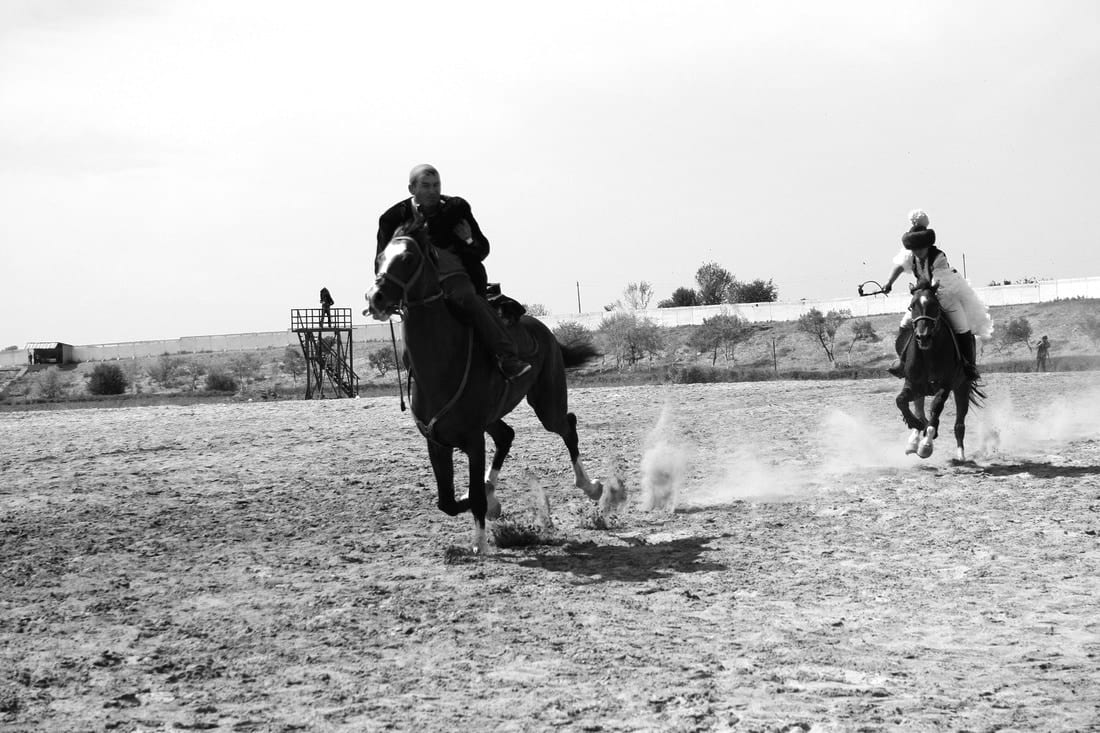
Follow us while we get lost


